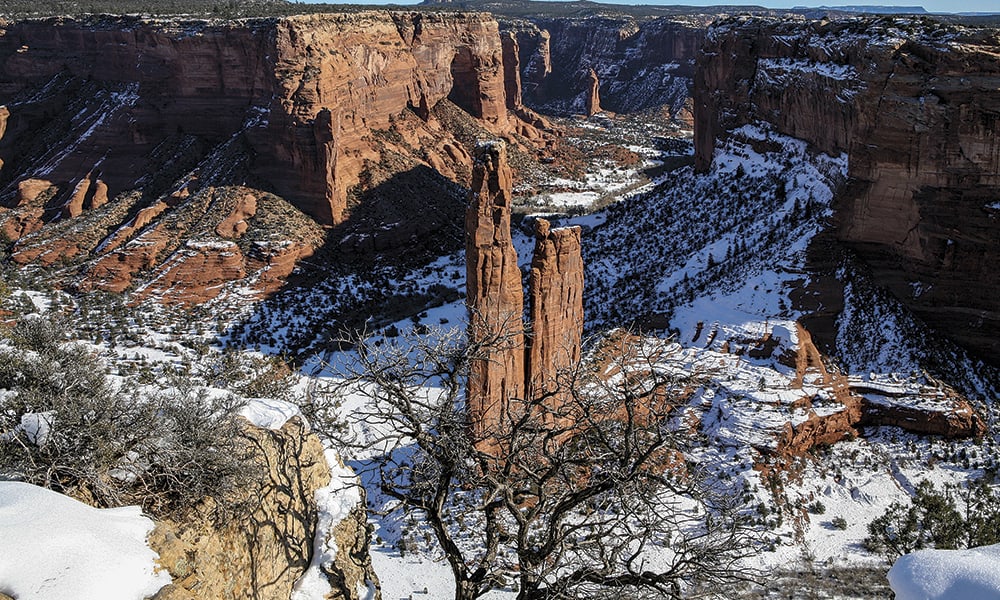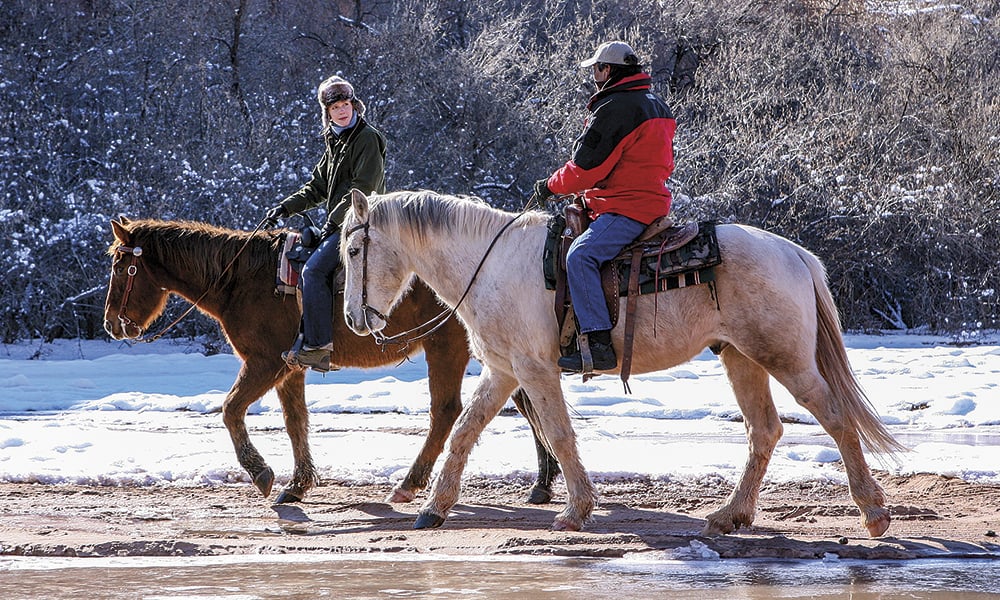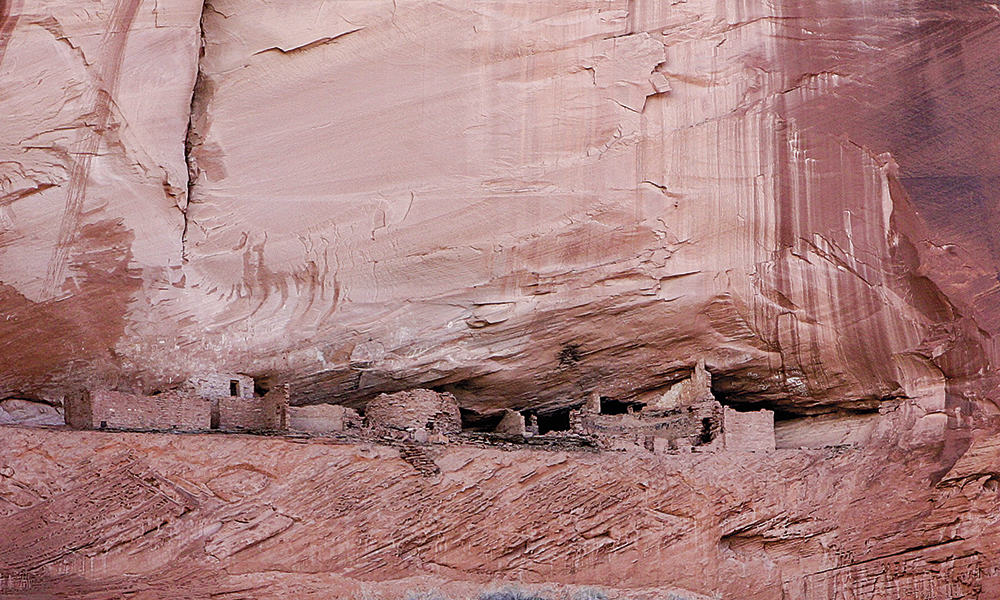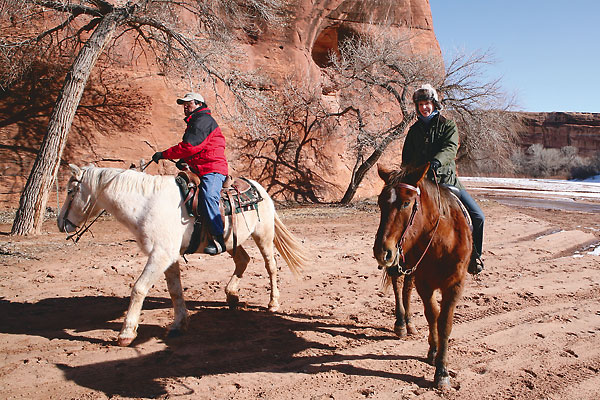If you want a truly spiritual horse ride in a spectacular setting, ride with the Navajo at Canyon de Chelly in Northeastern, Arizona. I’ve ridden through some pretty amazing scenery and was blown away as I rounded a bend to see homes carved into a skyscraper sized red canyon wall.
These historic cliff dwellings once housed dozens of families and were built sometime between 1100 and 1300 by the Ancestral Puebloans, known by the Navajo as the Anasazi. My small Quarter horse Mustang mix named Quarter Moon led me between the thousand foot canyon walls, discovering petroglyphs and pictographs – a sort of historic tour on horseback. Lee Bigwater, my horse riding guide from Totsonii Ranch, spent his childhood summers with his grandparents in the canyon and described the close-knit community who lived together here.
The Pueblo people hunted and farmed in the canyon more than 1,000 years ago, and some Navajo, who settled the canyon in the 1700s, still reside here today. On a longer ride into the canyon, pass through small forests of cottonwood and Russian olive trees and across various streams to reach Spider Rock, an 800-foot sandstone spire that rises to the sky. According to Navajo creation stories, this monolith is the home of Spider Woman, who taught the Navajo the art of weaving.
We rode out of a small area shrouded in cottonwoodtrees to see the cliff dwellings of the Ancestral Puebloans, known by the Navajo as the Anasazi. These spectacular ruins are carved high into a red sandstone cliff, and they were once dwellings, built sometime between 1100 and 1300, housing dozens of families.

Canyon de Chelly is one of the largest sandstone canyons in the nation, and riding through it is a humbling experience; I felt so small. The canyon walls remind Lee of New York City skyscrapers. Etched onto those walls are pictographs and petroglyphs, and sculpted in are cliff dwellings, all giving us clues about the canyon’s past inhabitants. Film buffs will also recognize the canyon as the setting for 1958’s The Big Country starring Charlton Heston and Gregory Peck.
Near the entrance to the canyon, Lee led me over to a wall adorned with petroglyphs, images carved into the rocks. I saw various handprints above us and a Kokopelli, the image of a man playing a flute. Lee talked about these mysterious images as I sat atop one of his Mustang Quarter Horse mixes named Half Moon, the eight-year-old half brother of Lee’s horse Chase.

In order to enter the interior of Canyon de Chelly, a monument that is supervised by the National Park Service and the Navajo Nation, you have to be accompanied by an authorized guide. This is a good thing. There’s something special about seeing the canyon with a guide like Lee Bigwater of Totsonii Ranch, who, as a child, spent his summers in the canyon. Hearing Lee’s stories made me understand the strength of the bond the Navajo community has with the canyon.
“We came down here in the summertime, just to help my mom and my grandmother, you know, herd the sheep in the canyon,” Lee says. “Early in the morning you could hear dogs barking at the next camp and people talking. They were so close…. You could hear people chopping their wood, talking, laughing.”
Getting in and out of the canyon is not easy. While we easily rode through on horseback, my camera crew members, who were filming us for my PBS TV series Equitrekking, got their vehicle stuck attempting to cross a river. Depending on the time of year, you’ll have to cross lots of rivers and streams within the canyon. Good thing Lee was there to call his friends, who could tow the car out of the water.
I could only imagine what life was like for the Pueblo people, who hunted and farmed in the canyon more than 1,000 years ago, and the Navajo, who settled the canyon in the 1700s. Lee told me about the two-day trip to the trading post that Navajo families would make, their wagons filled with sheep wool and mohair. They traveled the same dirt trails we rode, past sheer red cliff walls, some of which reach 1,000 feet high.
Life changed dramatically for the Navajo in the canyon in 1864, when Kit Carson oversaw a military campaign against them. For years, the Navajo had been raiding settlements in New Mexico. Under protest (he tried to resign his commission), Carson led a charge to destroy their food, shelter and livestock, forcing them to surrender. The Navajo traveled 300 miles to a reservation in Fort Sumner. Many died on this “Long Walk.” These Navajo wouldn’t return to the canyon until four years later, after signing a treaty with the government.

As Lee and I rode farther into the canyon, we passed sheep and cows, as well as Navajo homes. I could not imagine the chaos of the 1860s, because now everything was so quiet and peaceful, especially from my seat on my mount. I could imagine where the Navajo would hide, in the large crevices of a rock wall along the deep canyon. As we continued our ride, I began to understand why the Navajo believe that Canyon de Chelly is a spiritual place and why horseback riding is one of the best ways to experience its splendor.




